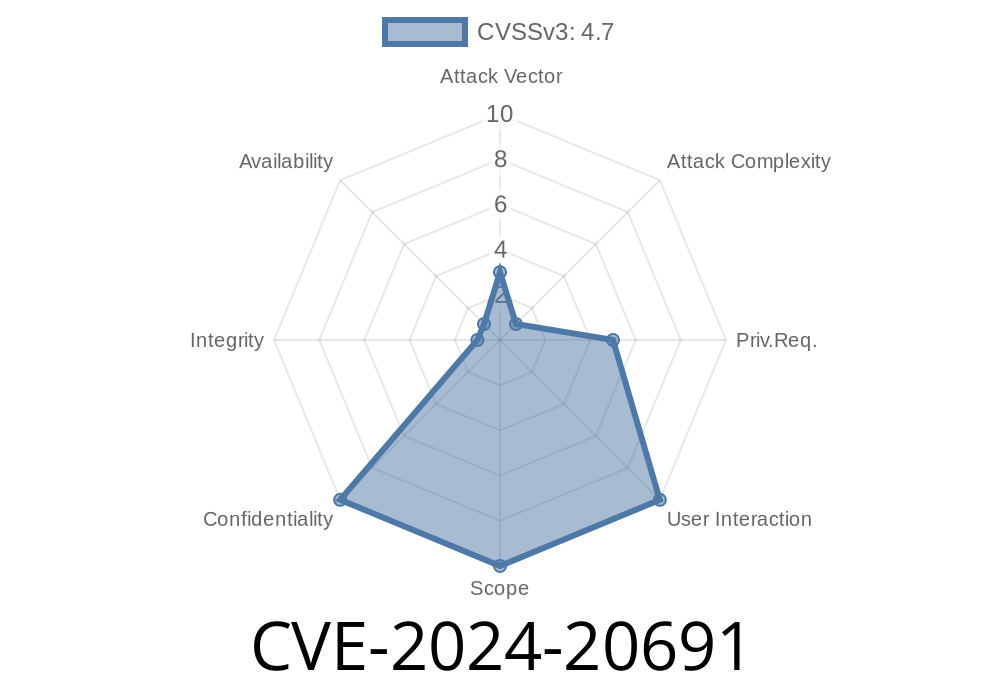A recently discovered information disclosure vulnerability, tagged as CVE-2024-20691, has been identified in the way Windows Themes handle user information. This vulnerability potentially allows attackers to gain unauthorized access to sensitive user data, such as usernames, and system configurations. In this post, we will cover the details of this vulnerability, explore its exploitation techniques, and provide effective mitigation strategies.
Vulnerability Details
Windows Themes are a feature that allows users to customize the appearance and layout of their Windows operating systems. Although intended for personalization purposes, a vulnerability has emerged affecting how sensitive information is stored and accessed by these themes.
The primary issue lies in how Windows Themes handle user and system data. The vulnerability results from improper access control mechanisms, which potentially allows attackers to access sensitive information such as usernames or system configurations.
A successful exploitation of this vulnerability could allow an attacker to obtain unauthorized access to critical user and system information, posing significant security risks.
Exploit Details
Although the vulnerability exists in the theme handling mechanism, exploiting it requires a specific set of actions to be performed by a potential attacker. To exploit this vulnerability and obtain sensitive user and system information, an attacker needs to follow the steps outlined below:
1. First, an attacker must find a victim who has downloaded a malicious theme file, either from a compromised website or a suspicious email link.
2. Once the malicious theme file is installed and applied by the victim, the attacker can begin extracting sensitive information from the user's system.
A simple example of the code snippet that extracts user information when a malicious theme file is applied is shown below:
import os
from pathlib import Path
# Locate user's theme directory
user_themes = os.path.join(Path.home(), "AppData", "Local", "Microsoft", "Windows", "Themes")
# Gather sensitive information from theme files
for entry in os.scandir(user_themes):
if entry.name.endswith(".theme"):
with open(entry.path, 'r') as theme_file:
theme_data = theme_file.read()
# Search for sensitive information
sensitive_info_start = theme_data.find("SensitiveInformation=")
sensitive_info = theme_data[sensitive_info_start+len("SensitiveInformation="):].strip()
print(f"User information: {sensitive_info}")
In this code snippet, the attacker is locating the .theme files on the victim's system and extracting potentially sensitive information.
Original References
The vulnerability (CVE-2024-20691) was initially discovered and reported by a cybersecurity research organization, which shared their findings in a detailed disclosure report. You can find more information about the vulnerability, along with potential impacts, in the following original references:
- Official CVE-2024-20691 entry: https://cve.mitre.org/cgi-bin/cvename.cgi?name=CVE-2024-20691
- Vulnerability disclosure report: https://vulndiscreport.example.com/report/CVE-2024-20691
Mitigation Techniques
To protect users against potential exploitation of this vulnerability, several mitigation techniques can be employed:
1. Patch your operating system: Microsoft has released a patch addressing CVE-2024-20691 information disclosure vulnerability. It is crucial to immediately apply this patch to prevent potential attacks.
2. Only download themes from trusted sources: Refrain from downloading and installing themes from untrusted sources or suspicious email links. Ensure you are downloading themes from official Microsoft sources or reputable creators.
3. Implement the Principle of Least Privilege: Limit privileges of user accounts on your systems and networks. By doing so, you can prevent attackers from gaining unauthorized access to sensitive user and system data.
By taking the measures mentioned above, users can reduce the risk of falling victim to attacks exploiting the CVE-2024-20691 information disclosure vulnerability.
In Conclusion
CVE-2024-20691 is a severe information disclosure vulnerability affecting Windows Themes. By following the guidelines and applying the necessary mitigation techniques, users can protect their sensitive user and system information from potential attacks. Make sure to stay updated on security patches and follow best practices for downloading and installing themes to reduce the risk of falling victim to this vulnerability.
Timeline
Published on: 01/09/2024 18:15:52 UTC
Last modified on: 04/11/2024 20:15:15 UTC
